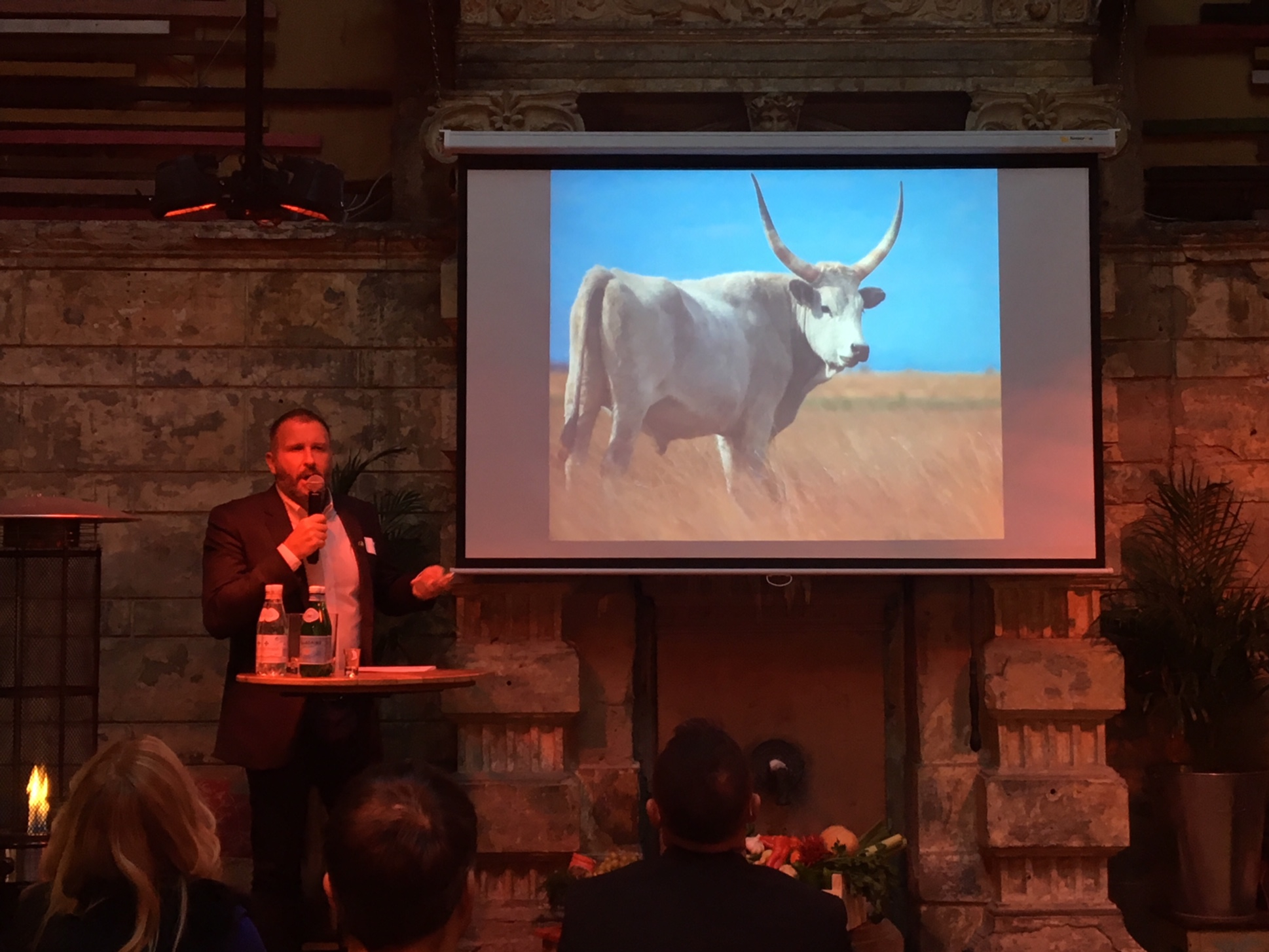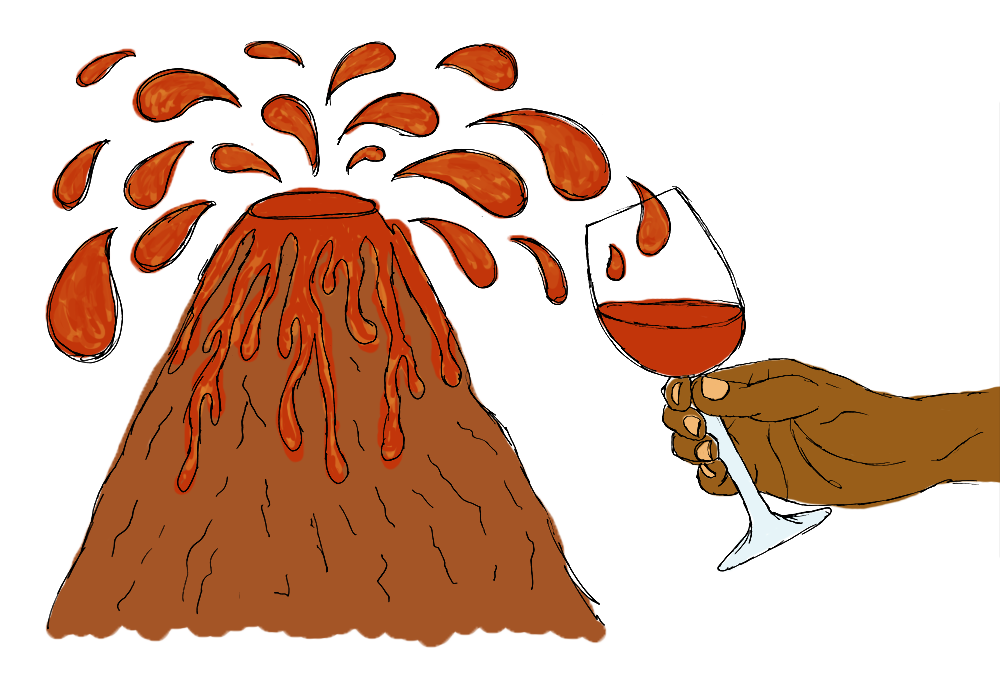Being from Istanbul, I have known a thing or two about Hungary: how it was under the Ottoman Empire for nearly 160 years, how the Orient Express passed through Budapest on its way from Paris to Istanbul, connecting the West to the East, and how the Hungarian-made Ikarus buses with their articulated bellies like accordions serviced Istanbul for half a century. What I didn’t know was how hip Budapest has now become, with its graffiti-adorned streets, trendy boutiques, and ruin bars converted from abandoned buildings.
My opportunity to rediscover Hungary arrived last October when Budapest hosted the Terroir forum, where chefs, journalists, winemakers, and sommeliers got together to discuss the legacy and the future of Hungarian gastronomy. When the founder of the Toronto-based Terroir Symposium, Arlene Stein, told me there would be local food and wine showcased, like Hungarian grey cattle, goose liver, and the sheep-like Mangalica pigs with their curly wool coats and marbled meat, I was intrigued. When she told me that there would be a wine-tasting event by the winemakers of Volcanic Wines of Pannonia, I was sold.
Although Budapest has a lot of attractions, including the thermal baths, the medieval Buda castle, and the largest synagogue in Europe, when you ask anyone who comes back from a trip to Budapest what they liked the most, they will tell you about its food, and especially about the comforts of a steaming goulash soup after a chilly day’s walk along the Danube River.
In fact, goulash is the first meal I have upon arrival. We have lunch at Stand 25, a bistro recently opened in the food market Hold Utca, created by young and talented Tamás Széll, Bocuse d’Or winner of Best European Chef in 2016. Inspired by his previous post at the Michelin-starred Onyx restaurant, he is serving simple traditional dishes, such as goulash, layered potatoes, and pork belly, prepared with the best ingredients and elevated to the level of haute cuisine by modern techniques.

Hungary has a long food history. The origins of Budapest can be linked to the Celtic people before it was conquered by the Roman Empire and later by Hungarians who came to the Carpathian Basin and established the Kingdom of Hungary in the year 1000. Hungarian cuisine, or Magyar cuisine, named after the primary ethnic group, is based on the nomadic lifestyle that is reflected in the most typical dishes like goulash, traditionally cooked over open fire. In the 15th century, King Matthias was married to Italian princess Beatrice, and with her came new spices to Hungary, such as garlic, ginger, mace, saffron, and nutmeg. The first written records of Hungarian gastronomy date back to this time (considered a golden age by many) and chronicle the most popular dishes as pork, beef, lamb, and game, served with gravy.
Later, the cuisine was influenced by Austria, when wiener schnitzel, cakes, and dessert came into play. After the Ottoman invasion in the 16th century, other new ingredients were introduced, like paprika, poppy seeds, and eggplants. As such, Hungarian cuisine has been weaved with international elements over centuries, and its food has always been a melting pot. Just like a pot of goulash, it reflects diversity and yet offers a familiar comfort.
Now, we finally notice the awakening of Hungarian food and wine, because it is living its renaissance and is getting ready to reclaim its place in the global scene. Before this renaissance, Hungarian cuisine had its dark ages during nearly 50 years of Soviet control, which had a crippling effect due to the export of most of Hungary’s raw resources and technology to the Soviet Union. More damage came from the purging of much of the former professional class. These events weakened Hungary’s industry and agriculture. In the ’50s, there were regular shortages in basic foodstuffs, with bread, sugar, flour, and meat being rationed. After the death of Stalin and the “thaw” of the Soviet Union, the Hungarian Revolution took place in 1956. In the ’60s, in fact, Hungarian communism was called goulash communism, a metaphor for diversity in its ideology.
The end of communism in 1989 marked the beginning of reforms in the economy and increased connections with Western Europe. Hungary joined NATO in 1999 and became a member of the European Union in 2004. With some ups and downs, the economy and the quality of life in Hungary have improved and the rate of unemployment has decreased. Ethnic and religious diversity has made for a smooth transition into democracy. Occupations, economic shortages, or political disagreements no longer hold back the country, especially not its vibrant capital, Budapest, that rivals any city in Western Europe with respect to history and culture. Government and European investment in central revitalization projects over the last 20 years have become catalysts for creating this vibrant scene.

At the Terroir forum, when the famous local writer András Jokuti takes the stage, he explains how the food scene in Budapest developed to international levels in no time. “Five years ago, I couldn’t recommend any restaurants in the city. Today, I can think of at least 30, and they are all very good,” he says. In fact, the two dinners leading up to the event were full of surprises: a modernist tasting menu at Babel Restaurant, reinterpreting the local flavors into new textures, and another dinner at Bistro Börze, where our meal was paired with local wines and celeriac and pumpkin palinka (the local brandy, traditionally made from fruits).
Another reason why Budapest is budding as a hip European city is the young population that is curious, creative, and courageous. They are forward-looking and optimistic and don’t feel held back by history. Hubert Hlatky-Schlichter, the manager of Babel Restaurant, highly rated for its creative local cuisine, has seen the city change tremendously in the last 20 years: “There was a huge reform. We just started to find our voice and our roots. As we are a multicultural capital with lots of passionate young entrepreneurs, all the trends are coming in. The food scene is very rich; wines are amazing and they are improving year by year.”
In fact, on the wine front, the story is similar. Winemaker Attila Tálos remarks during a wine tasting at his Bortarsarag wine store: “Hungarian wines were damaged by wars and communism, but we don’t want to look back.” After the ’90s, private enterprises started wineries and wine clubs. They were the pioneers, according to Tálos, and the generation today that followed them is taking things even further and learning to make world-class wines.
In Hungarian, wine is bor, not a word derived from vinum in Latin, a sign that winemaking was not introduced here by Romans and possibly pre-dates them. Even during Ottoman rule, wine never lost its popularity and economic importance. Its quality suffered when the phylloxera epidemic hit the vines in the 1880s and again during the communist regime when the state took over private vineyards, produced bulk wine, and ignored the centuries-old winemaking traditions. Every vintage tasted the same, as the harvest of all vineyards would be blended and processed in iron fermentation tanks.

Hungary hosts the famous red wine, Bull’s Blood or Egri Bikavér, from the Eger region in the east of the country. It’s a blend of three grape varieties: often Kekfrankos being the main grape blended with Cabernet Sauvignon and Merlot. According to legend, and there are many around wine, during the Siege of Eger in the 16th century, Turkish soldiers believed that bull’s blood was mixed into the red wine drunk by Hungarian soldiers. How could they otherwise find so much strength to resist and defend their castle? Then there is Tokaji, more correctly Aszú Tokaji, a sweet white wine made from grapes affected by noble rot, from the Tokaji region near the Carpathian Mountains in the northeast of the country.
Less known are the volcanic white wines, such as Olaszrizling from Balaton Highlands or Badacsony and Juhfark from the Samlo region. According to another legend, when a newlywed couple drinks Juhfark on their wedding night, they can conceive a male child — maybe because Juhfark is smoky and rich, a muscular volcanic wine. Other remarkable dry white wines are made with Furmint and Hárslevelű grapes. These are the most interesting grapes in the international scene, according to sommelier Mercedes Bachelet, another delegate of the event, who grabs a few bottles to take home to Sweden.
Volcanic geological remains run from Austria to Romania across the northern third of Hungary and the southern edge of Slovakia. Volcanic soil produces wines that are acidic, mouthwatering, mineral, and have a slightly salty finish. In this, Hungarian volcanic wines share a similarity with wines of Etna, the Canary Islands, and Santorini, all volcanic islands. Hungary is no island, however, and is ready to better connect with the rest of Europe and the world.
Robert Gilvesy, of Gilvesy Pincészet (Cellars), is optimistic for the future of Hungarian volcanic wines abroad: “So far, we have had success in North America and Northern Europe. Volcanic wines display refreshing and exciting acidity along with excellent aging potential and work best with food, so in this aspect, the world is open to us.” In fact, you can already see Hungarian wines in restaurants that are ahead with their wine lists. For example, uber-hipster Brooklyn pizzeria, Roberta’s, has Hungarian Furmint on their menu.
How the Hungarian renaissance of food and wine will develop remains to be seen. One thing is certain, and that is how well the new generation of growers, vintners, and chefs capture the region’s attributes, eager to share them with the rest of the world. •
Featured image created by Isabella Akhtarshenas. All other images courtesy of the author.




